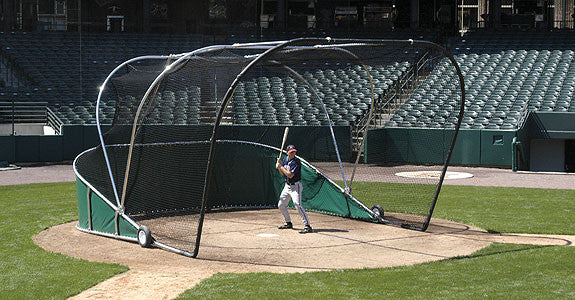Rapid Fire Ground Balls
This is a great way to end your traditional infielders’ positional work during practice. At the conclusion of your normal ground ball work at each position (third to first, short to first, second to first, 6-4-3 double play, 5-4-3 double play, 3-6-3 double play, etc.) have your infielders all gather at their respective positions and prepare them for rapid fire ground balls.
For example, your third baseman will be at his or her usual spot while the coach is hitting a fresh ground ball the split second he/she throws the ball across the diamond. This will make the fielder have a constant head on their shoulders and be prepared for whatever may come next (a ball hit to their left, hit to their right, a slow roller, a high chopper, etc.).
Since the ground balls are coming at a non-traditional rate, this will create a fun and competitive environment for your team and coaches. You’re also likely get some players that begin diving at balls and getting dirty, which will certainly get a rise from their teammates. Just make sure they’re still utilizing proper footwork and mechanics, as this drill can become a little bit chaotic.
This take time and work to get players to learn how but it is a great drill and will pay off with ball handling in the game.
CREDIT TO: thehittingvault.com
In this time of having to stay home bound players are board and on the computer for many hours. But while I advocate for them getting outside and being active there certainly are some activities that they can do on that computer that will improve their mental knowledge of the game and maybe give them insight.
Here's a few that might work for you but please encourage your player and/or yourselves to look the sites using Google or any other search engine and specific questions.
Stay mentally sharp as well as physically getting ready for baseball and softball to start.
======================
http://www.freeonlinebaseballgames.com/
====================
Try this type activity while you are home safe.
Question on how to Tag out runners in the basepaths
When no one around, improve by yourself, one man drills
One of the biggest concerns that coaches and associations have these days is with pitchers and the care of their arms. Ultimately it really is the coach that needs to watch this but parents, associations, leagues, all have different thoughts and recommendations. I ran across this article from USA Today that has some nice information, and while it's not the only thing it certainly is something to consider. One side note in this conversation you as a parent must be aware of how much your son or daughter is pitching because many times a really good pitchers is playing on more than one team and therefore can accumulate more pitches than he/she should throw within a time. Because it's league is only keeping track of that one so you could even get caught up and throwing double what the boy/girl should be allowed. He was a parent need to monitor this.
I have a grandson that played in California, there league went so far as to count 35 pitches against the catcher if he came into pitch. And there league which was 14 and under if a catcher came into pitch he automatically had 35 pitches against out of the 70 possible so this is even a case of a league going a little further toward pitch count and arm care.
It is interesting to note that because of the arm motion softball pitchers can and do pitch huge number of pitches with no arm problems while we should be cautious there are no recommendations for softball, the pitcher will tell you by just looking, listening, and using common sense.
This one came from US a baseball medical and safety advisory committee: and published with their permission.
USA Baseball Medical And Safety Advisory Committee Guidelines
Age Max Pitches Game Pitches Week
8-10 50 75
11-12 75 100
13-14 75 125
15-16 90 2 Games Week
17-18 105 2 Games Week
Ages To Learn The Different Types
Pitch Type Age To Learn
Fastball 8
Changeup 10
Curveball 14
Knuckleball 15
Slider 16
Forkball 16
Splitter 16
Screwball 17
Survey Of Types Of Balls Thrown ~ Ranked Least To Most For Pain Caused
Fastball
Changeup
Curveball
Slider
Survey Conducted By Dr. Joe Chandler, Team Physician, Atlanta Braves on 101 Braves Hurlers In 2000
We just came across to the new rule that's going into effect for the 2017 softball season at the NCAA level.
The dugout faces must be completely enclosed with netting or protective material all the way up to the roof line. This is for the player protection from foul balls, thrown equipment, thrown balls anything that could cause an injury entering the dugout.
I don't know that there been that many cases of injury, but there must've been something that precipitated this move and rules and move like this are not normally preventive their reactionary. I don't know what did it for my guess is there is one. Baseball and softball players are known for hanging on the dugout fence, being over it, even being outside of it and having to duck out of the way of balls flying in there.
I'm an umpire and have seen it along with being a coach for over 40 years so I don't know that it's a bad rule. The question I have for your comments is should all dugouts be protected from the ball getting into that dugout whether it be baseball, softball, no matter what the league.
I may be dating myself but I can remember dugouts that were ground-level and had no protection in front it was like sitting on a bench in a shed watching the games. Then the normal progression was to put up fences about 3 to 4 foot high to protect, then bring down lips from the top of the dugout have become standard. Now is this the evolution of dugout protection that's the question? Agree or disagree
Tip No.1: Don't Bunt With Two Strikes
This is a tough one when it fails. We have all seen it in youth baseball when the third baseman plays in close anticipating a bunt.
When the strike count gets to two, the coach will yell to the third baseman something like this: "Two strikes on the hitter. Move back so you are even with the base."
When the fielder moves back, depending on the ability of the batter, I love to give him another chance to bunt, given that the defense and opposing coach are sure the batter will not bunt. I have been successful with this and at other times it has failed.
One warning, if you try this. When your batter does fail, you will hear from all the "General Managers" in the bleachers.
More: 4 Biggest Mistakes Baseball Teams Make in Practice
Tip No.2: Catch Everything With Two Hands
I know most coaches and parents will hold me to task on this one. When my players are moving laterally reaching for a fly ball, I just want them to catch the ball any way possible.
I don't want my players thinking they have to catch everything with two hands if some catches are easier one-handed. If the shortstop is sprinting for a pop-up behind the third baseman, and has to reach for it, a one-handed catch works best.
When catching a pop-up hit right to a player, with little or no running, a two-handed catch works best. But too many coaches and parents overemphasize catching everything with two hands. Coaches need to have youth players practice catching balls with one and two hands.
Tip No.3: Don't Make the First or Third Out at Third Base
Tim McCarver won't invite me over to dinner on this one. I send my runner to third most of the time not worrying about how many outs we have.
I have my teams run the bases aggressively. We get thrown out at third and home more than other teams. But we also win more games than we lose.
More: Drill of the Week: Baseball Catching Drill for Kids
In youth baseball, every game has its share of wild pitches and passed balls. From my many years coaching third base I know that we have a great chance getting the runner home on a wild pitch or passed ball.
I hate ending the inning with a player who doesn't score from third base when some aggressive baserunning would have landed him on third and he would have scored.
Tip No.4: Bigger Baseball Gloves are Better
I was guilty of this when my oldest son played Little League. Every year I wanted to get him a bigger glove figuring the larger the glove, the better chance of the ball landing in the pocket. I was 100 percent wrong on this.
I remember going to Yankee Stadium with a close friend who had an "in" on everything and knew a lot of people. We had front row seats and before the game one of the Yankee infielders came over to say hello to my friend.
As they were talking, I could not keep my eyes off the player's glove and was amazed at how small the glove was. It just about outlined his hand.
I then learned that "glove control" is key for fielders. So, smaller rather than bigger gloves are better, especially for infielders, except the first baseman.
More: 5 Ways to Get Noticed at a Sports Camp
Tip No.5: Bat Your Best Hitter Third or Fourth
Years ago I remember in a few All-Star games, Willie Mays batted leadoff. I know the theory is that you get a couple of batters on base and the big guns will drive them in. I don't agree with this all the time.
I found that in youth baseball sometimes there is a large disparity with the talent of the players. Many times teams have one or two excellent players.
In youth baseball I prefer to bat my best hitter first or second. I cannot tell you how many times my team was down by a couple of runs in the last inning with the bottom of my batting order up.
If my best player batted third or fourth, I'd be doing everything I could to get him up but many times games ended up with my best hitter on deck. Now I like to bat my best player first or second. (I know you might think I'm sacrificing some runs but I love the idea of him getting an extra at bat a game.)
Like everything in coaching your talent at the moment will determine your move as the manager or coach. The term "thinking outside the box" has been overused in many instances.
But when coaching, you do want to think outside the box if it will give your players and team an advantage to succeed. Unpopular decisions may be the best decisions at the time you make them.
Marty Schupak
We are a new team and not all that good, how do I create a positive atmosphere and keep the players motivated and enjoying the game as they play.
The biggest deal here is that you don't worry and you make a huge deal out of the score not being important. What is important is each accomplishment is what you celebrate and just like hitting the ball and running or picking it up and throwing. Your letter indicates that your worrying about motivation, when in truth just playing to be all the motivation they need not sure hundred percent what you mean by motivation. But little kids like that normally just love to play, let them play in different positions and set goals that you know they're going to accomplish. Just like this past Sunday we had three goals--- for six out of the 12 players to hit the ball, to make one out in the field, and scored one run and we were able to do that because of the way the league is built - inning consists of three outs, seven runs, or batting through the order when we change. We know that were going to accomplish almost every one of these and this week we will have a little different set of goals, but that's what were you tell them are going to try to do and have fun. Then after the game we will make comment immediately away from the parents. So is just you and the coaches and the players talking to each other about what you got accomplished today and how much fun it was. Make no mistake about it all you're doing is creating organized play with this age group you're not creating baseball players you're creating social skills, fun, and organizational aspects that they will need to work with. But winning and losing is the last thing that needs to be even brought up.
The very first year I coached we were eight year olds in a 10 under league we were 0-44, and the thing they remember to this very day is that we went to Pizza Hut and celebrated a rainout. but by the time they were 12 years old we were 2nd in the BABE RUTH WORLD SERIES for 12 and under.
Let me know what you think and hope that I've created some thought process.
Coach Arnald Swift
Below is a stock answer for concentration and pitch recognition along with being confident at the plate.
Try it and I believe that the player will start to hit and catch better.
For catching take way his glove and play catch with a foam ball or plastic ball then get a baseball and do the
drill I talk about below. We have to get over any fear and use to the ball. Believe it or not when they first
start the glove just gets in the way so eliminate it most of the time.
As simple as this sound get a piece of plywood, prop it up at and angle, have him or us throw the ball up the
board and then field it as it rolls back down.
The for fly balls or high throws, throw the ball onto a roof and catch it as it comes off, it is fun and teaches
throwing and eye hand coordination. Use a rubber ball or tennis ball gives a safer aspect to it if you so
desire.
Coach Arnald Swift
Common Issues With Young Baseball Players & What To Do As a Coach
If you are coaching young baseball players these will undoubtedly be three issues that you will encounter quite frequently. Hopefully these tips give you a good idea of how to correct things and get your young troops back headed in the right direction with their skill development. If you have any of your own coaching techniques or other common issues you encounter, please share them with us in the comments section below. Thanks for your time!
There are many different technical issues that young baseball players have when starting out but some seem to be a lot more common than others. Here are a few problems that are consistent with most kids and what you can do as a coach and/or parent to help steer them in the right direction.
Throwing
Every person that’s ever thrown a ball has their own technique that is slightly different in some way than everybody else’s. However, even though everyone throws differently, many still have the same problems. The most common problem that I see with kids throwing the baseball is the direction their body is going in when they throw. What typically happens is players will direct their momentum towards their glove side, instead of having it all going towards their target. This can happen for many reasons but typically it has to do with their glove getting away from their body during the throw and pulling them away from their target instead of towards it. Once your glove starts moving away from your body as you throw, it’s likely that your momentum will follow in the same direction. The consequences for your momentum being directed in other places than your target are typically a loss of velocity as well as accuracy. So make sure that your youn baseball players are directing momentum towards their target whether it be a catcher or a teammate in the field.
Hitting
There are very few techniques in sports that are debated more than hitting a baseball. But one consistent technique that’s taught is that when a player strides, it’s best for the stride to be going straight. A problem with a lot of younger hitters, however, is they will step away (usually opening up). Once you step away, your front shoulder will open up and allow your head to pull off, which will also increase the likelihood that your bat will not be in the strike zone as long as it could be. So before adjusting any technique of a hitter, make sure their stride is at least going forward to give the rest of their body a chance to do other things efficiently.
Fielding
A very common mistake that kids make while fielding a ground ball is where they position their glove when picking up the ball. What most kids like to do is put their glove straight down between their legs. The problem with this is when the ball is on its way, you cannot see your glove and watch the ball at the same time, meaning you can't see the ball into your glove (or as close as possible...sometimes it can be too fast to track right in). So you have to get your glove out in front of you so that you can see the ball in (like Dustin Pedroia in the picture above). This technique will also help you adjust to bad hops by giving you the opportunity to move your glove back to your body if necessary. It’s a lot easier to adjust bringing your glove in than adjusting it out.
Kevin Hussey










